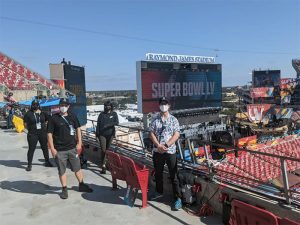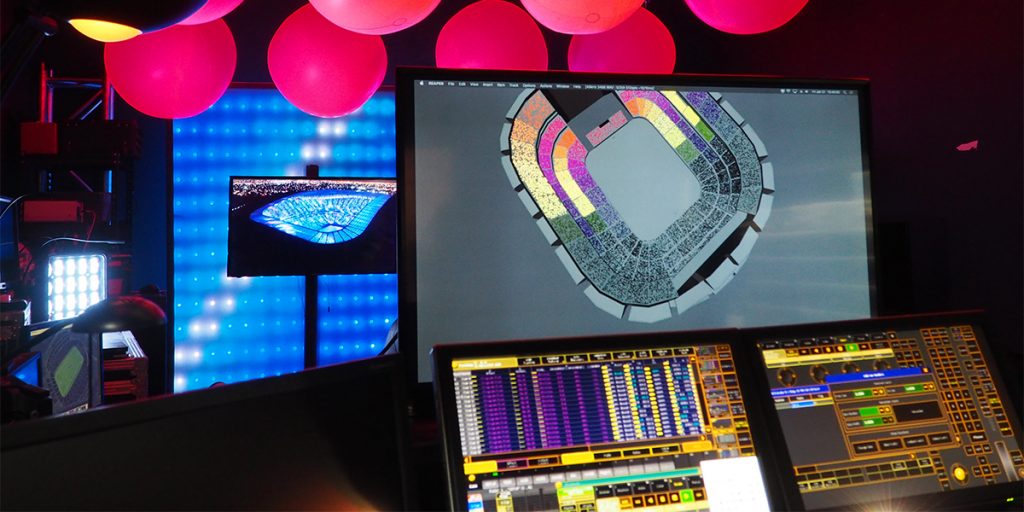PixMob provided an unforgettable spectacle for Super Bowl LV, despite a challenging year for North America’s biggest annual sporting event. Taking place on 7 February at Raymond James Stadium in Tampa, Florida, Super Bowl LV played host to an estimated 25,000 socially distanced fans – a third of the stadium’s capacity – as well as thousands of cardboard cutouts and a career-spanning performance by The Weeknd during the Halftime Show.
Employing around 30,000 LED wristbands for live audience members and cardboard cutouts, 500 ultra-powerful LED “flares” for the performers on the field and 75 LED face masks, PixMob demonstrated its ability to turn audiences into part of the show while creating an “entrancing” canvas of light for viewers at home. Gaps in the empty seats were filled with lights and cardboard cutouts. In the daylight, the cardboard cutouts represented 2D audience members, while at night, with PixMob pixels, during the show the entire stadium came alive with light.
“We’re very happy and honoured to be doing the Super Bowl Halftime Show for a second year in a row, especially during these exceptional pandemic conditions,” PixMob President, Jean-Olivier Dalphond commented. “We approached it as both a challenge and an opportunity, and we are very pleased to have been able to offer such an uplifting experience for everyone watching this extraordinary event during these unprecedented times.”
Having played a key part in the 2014 and 2020 event, Dalphond underlined the unique nature of Super Bowl LV. “The biggest difference this year was the COVID-19 protocols, which were implemented by organisers and which the team adhered to on site,” he explained, walking TPi through the frequent testing, PPE and social distancing requirements. “The NFL applied the most comprehensive COVID-19 secure health and safety restrictions possible to ensure the safety of the crew, performing artists and sports teams. Above all, our crew felt safe on site.”

PixMob Executive Producer, Sophie Blondeau; Technical Directors, Jacques Vanier and Christophe Lessard-Drolet; Pixel Manager, Samantha Lynn and Programmer, Rafael Linares – who supported remotely from Sweden, due to COVID-19 travel restrictions – worked closely with Eric Marchwinski of Early Bird Visuals on programming and integration. “Equipment was installed into the upper tiers of the rig. If you factor in the humidity and 30° weather, the team came out as the real heroes of this project,” Dalphond remarked.
With artists performing in close proximity, veteran Super Bowl Production Designer, Bruce Rodgers enlisted the support of PixMob to create “LED eyes” on top of 75 facemasks. “We had the entire space of the field to play with, so we created a unique source of light in the hand flares, in collaboration with the creative teams, to provide a unique experience for the audience in the stadium and those watching at home,” Dalphond said.
PixMob kit was triggered and operated by an MA Lighting grandMA2 console, through standard DMX protocol, using infrared PAR light, referred to by Dalphond and the team as “wash transmitters”, which send a signal to select objects. “We were able to provide a PixMob infrared moving head to the Super Bowl, for the first time,” Dalphond enthused. “We sent out infrared data that the wristbands receive and interpret to create waves via infrared control. This allows us to independently control different elements, such as the eyes, hand flares, and audience wristbands from the console. It’s a rather elegant rigging setup, with six moving heads covering the span of the entire stadium.”
SAFETEAMS
Renowned for its collaboration on tours with Taylor Swift, Shawn Mendes and the Spice Girls in recent years, as well as being a key player in the opening ceremonies of the Olympics, NHL and NBA playoff games, PixMob has shifted and adapted to the so-called COVID-19 era with the creation of Safeteams – a bold new initiative tackling the pandemic in the events, commercial and industrial sectors.
“We’ve had to diversify dramatically. In one week, all of our business stopped last year,” Dalphond said. “However, because we are a company that creates its product from A-Z, we have been able to pivot our R&D capabilities towards searching for and piloting solutions in the fight against COVID-19.”
Utilising PixMob’s proprietary wearable technologies, Safeteams assists organisations wishing to reopen or maintain safe operations during the COVID-19 pandemic. Safeteams provides social distancing and contact tracing solutions that create safe work environments through the use of connected devices designed to help stop the spread of the virus within workplaces. “With an extreme market response, we’ve created Safeteams’ wearables that record interaction between 2m, enabling social distancing and tracking the spread COVID-19,” Dalphond explained. “We have a hub that connects to mobile data, which can be transferred within range of a mobile network, for contact tracing.”
Although there are possibilities for the live events sector and the touring world to adopt Safeteams, by the time tours are permitted, contact tracing will, hopefully, be a thing of the past. However, Safeteams could also double as a real-time location service for kit. “You would be able to find the equipment on tour in an instant, being able to localise them in space,” Dalphond noted.
Adoption of Safeteams has already been extremely high, with over 50 US, Canadian and Quebec-based companies now working with the technology, including: CanSave, Metal Power Product, Courchesne-Larose, Moderco and All Weather Windows, with more to be announced soon. “Although Safeteams has been adopted strongly by the industrial sectors – such as meat preparing plants and bottling industries – interestingly, our fastest-growing market is TV and broadcast, where COVID-19 solutions must be deployed rapidly for shooting, which is what we’re good at.”
‘COLLECTIVE EXPERIENCES MAKE US FEEL HUMAN’
Reflecting on the success of Super Bowl LV, despite the pandemic-related hurdles, Dalphond and the crew were “grateful” to be back to some semblance of normality. “There is a sense of accomplishment from us to still operate and collaborate with the creative minds behind the Super Bowl,” he said. “Despite being away from our typical day to day for so long, the project was seamless, which is testament to the crew’s expertise.”
According to Dalphond, as well as developing solutions for COVID-19, creating immersive experiences is key going forward. “Before the pandemic, the live events industry would consider spectacles as rituals. Rituals allow you to mark the time, relationships and transitions in life. We are now devoid of collective rituals, so the idea of watching Super Bowl LV, in person or on the television, brings a sense of normality and aspiration in such dark times. After all, collective experiences like this make us feel human.”
This article originally appeared in issue #259 of TPi, which you can read here.
Photos: PixMob


